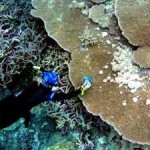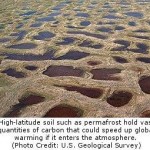Their model predicts that as air temperatures rise and equatorial trade winds weaken, the Pacific surface current will also weaken by 15 percent by the end of the century. The then-weaker surface current will impose less friction and drag on the EUC, so this deeper current will strengthen by 14 percent.
“Our model suggests that the amount of upwelling will actually increase by about 50 percent around these islands and reduce the rate of warming waters around them by about 0.7°C (1.25°F) per century,” Karnauskas said.
A handful of coral atolls on the equator, some as small as 4 square kilometers (1.54 square miles) in area, may not seem like much. But Karnauskas’s and Cohen’s results say waters on the western sides of the islands will warm more slowly than at islands 2 degrees (or 138 miles) north and south of the equator that are not in the way of the EUC. That gives the Gilbert Islands a significant advantage over neighboring reef systems, they said.
“While the mitigating effect of a strengthened Equatorial Undercurrent will not spare the corals, the perhaps-inevitable warming expected for this region, the warming rate will be slower around these equatorial islands, which may allow corals and their symbiotic algae a better chance to adapt and survive,” Karnauskas said. If the model holds true, then even if neighboring reefs are hard hit, equatorial island coral reefs may well survive to produce larvae of corals and other reef species. Like a seed bank for the future, they might be a source of new corals and other species that could re-colonize damaged reefs.
“The globe is warming, but there are things going on underfoot that will slow that warming for certain parts of certain coral reef islands,” said Cohen.
“These little islands in the middle of the ocean can counteract global trends and have a big impact on their own future, which I think is a beautiful concept,” Karnauskas said.
“The finding that there may be refuges in the tropics where local circulation features buffer the trend of rising sea surface temperature has important implications for the survival of coral reef systems,” said David Garrison, program director in the National Science Foundation (NSF)‘s Division of Ocean Sciences, which funded the research.
Details of the Study:
Source: WHOI.














